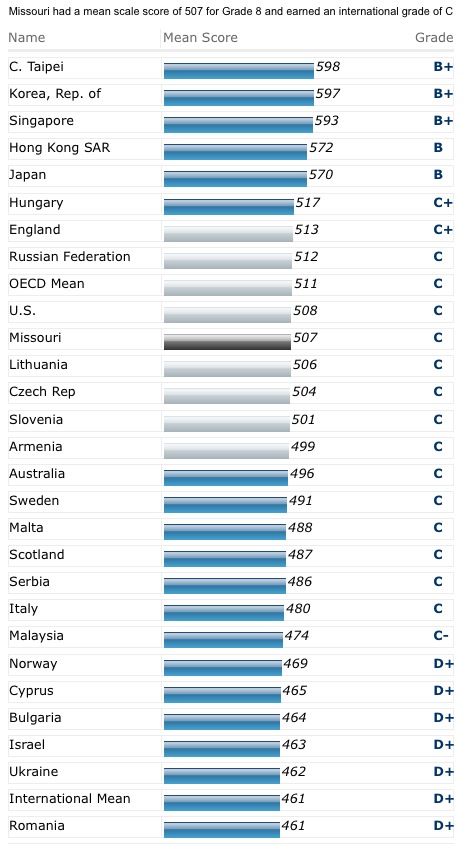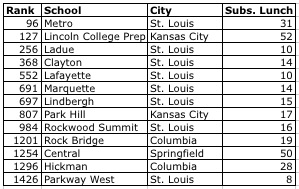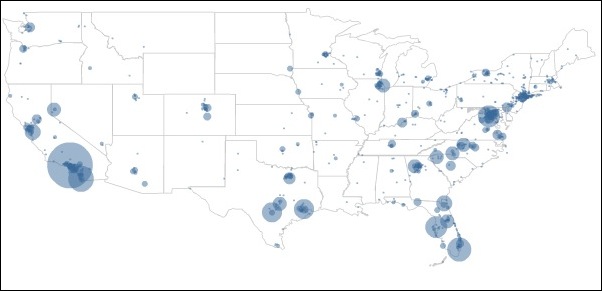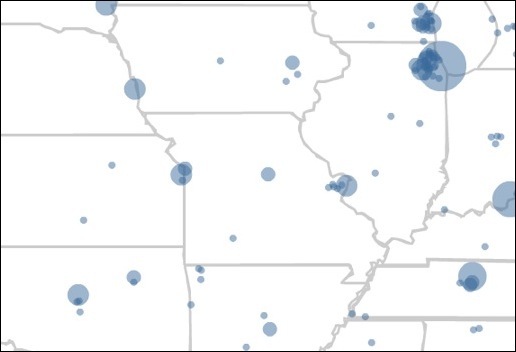Math standards—Lowest Common Denominator?

Photo by ansik
Should Missouri math standards be written as the minimum that students should learn, which would be too low for most students, or should they be written for most students with expectations of extra help for struggling students? Currently, they are written to be the minimum, but a group of math professors believes they should be raised.
Statement in the revised draft as of 18 May 09:
Although the core content, learning goals, and performance indicators specified in this document are intended for ALL students, many Missouri students will be able to move through this content more quickly and will need more mathematics than is outlined here. For that reason, we urge local educational agencies to develop and implement policies and programs serving all students beginning in elementary school, including those who are ready for early advancement and need more mathematics than the material described in this document. As essential support for raising Missouri’s performance in mathematics, specification of core content, learning goals, and performance indicators for fourth-year high school mathematics courses is under development.
math learning goals 051809 - sh - 2
are published, schools will base their curricular decision on these low standards and will already be committed to these curricular decisions." rel="external">Response to Missouri State Board of Education 29 May 09 by Ian Aberbach, professor and director of undergraduate studies, mathematics dept., University of Missouri—Columbia:
If the current standards aimed no higher than to 20th percentile students (ALL) are published, schools will base their curricular decision on these low standards and will already be committed to these curricular decisions.
Yes, the state plans on adding an addendum with supplemental standards for college-bound students, but we should not have a two-tiered approach. All students should graduate from high school prepared for college, whether they choose to continue on or not. The two-tiered approach is not in alignment with Obama’s goals nor is it the best decision to keep Missouri competitive either nationally or internationally.
(Hat tip to Lisa Jones for the links)
Missouri beats Lithuania by one—in math

photo by apesara
Last fall, I blogged about the importance of comparing our students not just to other students locally or to other states but internationally. Ideally, we would have information for individual districts, but until we do, the American Institutes for Research has released a report that allows you to compare individual states with other countries. Missouri, not surprisingly, is right at the U.S. median for both fourth and eighth grade math scores.
At the fourth grade level only six states received a B; by eighth grade only Massachusetts received a B.
“These Asian nations consistently perform at the B+, B, and B- levels,” Phillips [acting commissioner of the National Center for Education Statistics from 1999 to 2002] said. “Their students are learning mathematics not just at a higher level than students in the United States, but at a level that is a quantum leap higher.” The math proficiency average for U.S. students is C+ in grade 4 and C at grade 8. (AIR news release 16 June 2009)
Since Missouri is right behind the U.S. average, we are not competing well against Asian students.
“Our states and school districts should no longer be comparing themselves to their neighbors. They will be competing for jobs and innovations with students around the globe.” (AIR news release 16 June 2009)
I’ve said that before.
our states and school districts fall comparatively further behind in Grade 8 than they do in Grade 4. Although the United States falls further behind in the higher grade, the highest achieving countries maintain their level of performance. AIRInternationalBenchmarks2009
The middle school problem is real in the United States and, apparently, Missouri also. As a culture we are more concerned about their social lives than their academic abilities. Our expectations are not high-- “They can’t think clearly with all those hormones!” --but they obviously work hard in other countries. I would love to see if any of our middle schools are bucking this trend.
Here is the chart showing where Missouri places compared to other countries for eighth grade math. The grey bars are for countries with scores that are considered statistically similar. The interactive chart is fascinating to play with. I eagerly await the time when we can put individual school districts in for comparison.

Nixon needs to act on standards, now!
Missouri is one of only four states to not have the governor sign on to work together to create a set of voluntary national standards. Texas, Alaska and South Carolina are the other three--conservative governors with presidential aspirations is the common denominator among them.
Why didn’t Gov. Jay Nixon sign on for Missouri? presumably because we are currently without a commissioner. However, since this was an association of governors, Nixon has the authority, the responsibility to lead the state. He doesn’t have to wait until a new commissioner is hired.
But the state doesn’t have that much time. Panels are working on suggested standards set to come out in July.The president of Missouri's board of education said he, too, expected his members to revisit the issue soon."I think we'll seriously consider it over the next several months," said state board President Russell Thompson. "Once we're assured Missouri can have higher standards." (Missouri Balks, St. Louis Post-Dispatch)
Later, a separate national "validation" panel, made of up of experts nominated by the states, will review the proposal. (46 States, Washington Post)
If we wait too long, we won’t have a chance to review the proposal. We have to make that deadline.
Some (such as Caitlin Hartsell for Show-Me Institute) say we don’t need to join the common standards movement because Missouri already has high standards.
And, as it is, fewer than half of Missouri’s students are meeting or exceeding the MAP standards Adopting lower national standards instead would only provide a misleading inflation of achievement metrics.
But this is mixing up the challenge level of the MAP, which is high, with the Missouri standards, which are not. In fact the math standards are under review, which is being extended because of disagreement with the draft standards.
The math wars are nothing new, but the rigor of the Mo. standards is not high, is confusing and contains jargon.Members of prominent university mathematics departments in Missouri are calling for an evaluation of state standards and expectations in K-12 math curriculum. (Math Professors, Columbia Missourian)
For example, for fourth grade, the proposed standard is broken into Core Concept, Learning Goal and Performance Indicator. (Ed. to add--I chose this somewhat randomly. I’m familiar with 4th grade, and fractions are difficult and important. I did not pick and choose.)
Grade 4, Core Concept B--Develop understanding of decimals, including the connections between fractions and decimals.2) Understand relationships among whole numbers, commonly used fractions, and decimals.
- Model fractions (halves, fifths fourths, eighths, and tenths) on a 10 x 10 grid representing one unit in order to convert fractions to decimals.
- Rename whole numbers as fractions with different denominators (e.g., 5 = 5/1, 3 = 6/2, 1 = 7/7), with or without models.
- Relate fractions with denominators of tenths and hundredths to decimals of equivalent values.
- Identify equivalent fractions and decimals (less than one, equivalent to one, and greater than one), with and without models, including locations on a number line.
- Use a variety of methods to compare and order decimals and fractions.
Compare this to a similar California standard:
Number Sense
1.0 Students understand the place value of whole numbers and decimals to two decimal places and how whole numbers and decimals relate to simple fractions. Students use the concepts of negative numbers:
1.1 Read and write whole numbers in the millions.
1.2 Order and compare whole numbers and decimals to two decimal places.
1.3 Round whole numbers through the millions to the nearest ten, hundred, thousand, ten thousand, or hundred thousand.
1.4 Decide when a rounded solution is called for and explain why such a solution may be appropriate.
1.5 Explain different interpretations of fractions, for example, parts of a whole, parts of a set, and division of whole numbers by whole numbers; explain equivalents of fractions (see Standard 4.0).
1.6 Write tenths and hundredths in decimal and fraction notations and know the fraction and decimal equivalents for halves and fourths (e.g., 1⁄2 = 0.5 or .50; 7⁄4 = 1 3⁄4 = 1.75).
1.7 Write the fraction represented by a drawing of parts of a figure; represent a given fraction by using drawings; and relate a fraction to a simple decimal on a number line.
mathstandard
As a state with a difficult assessment, I think we’ll benefit from a common standard. We won’t look bad when compared to states with easy assessments when they upgrade their tests. We won’t need to “dumb down” ours; instead, the rest of the country will need to catch up to our assessments. In fact, our standards need to catch up to our assessments.
Agreeing to work to create the common standards is not the same as agreeing to follow and change the MAP to assess by the common standards. This first step is a no-brainer. I’ll wait until the actual standards come out to make a decision on the next, but with our transient population that needs to meet international standards I applaud the effort and strongly encourage Gov. Nixon to sign on today. Otherwise, we’re likely to be looking at standards we did not have a role in helping to create.
Let them eat...zucchini?
| The Daily Show With Jon Stewart | Mon - Thurs 11p / 10c | |||
| Little Crop of Horrors | ||||
| ||||
With the attention paid to our nation’s pathetic eating habits and the Obama’s organic garden, now seems to be a good time for the St. Louis area school districts to vastly improve their school lunches. Maplewood Richmond-Heights is in front of the “Race to the Top”, in terms of lunches anyway, as it implements its Healthy Eating with Local Produce grant in conjunction with St. Louis University.
"The kitchen staff has reshaped menus and already ordered their produce from the farmers in the Missouri Farmers' Union," superintendent Henke said. "Some of our high school students will have summer jobs helping process the foods this summer." (Gardening Teaches, Suburban Journals, 2 June 09)
This is in sharp contrast to most of the area school districts. Yes, they may offer some fresh fruit and vegetables at a food bar, a recent and welcome addition, but the overall menu is still weak.
Here’s a typical week’s menu. This one is for elementary schools from one week in May from Kirkwood school district, which uses Chartwells.

Here’s a menu from Chef Ann Cooper’s elementary menu (pdf). A daily menu might be chicken or veggie quesadilla, rice and beans, salad bar, 1% milk, fresh fruit.
Elem_calendar_sept
Like Maplewood, Kirkwood, U City, Ferguson-Florissant, St. Charles and Clayton have farmer’s markets within their borders. Let’s step up to the plate, schools.
Best high schools list out

The perennial Newsweek best high school list compiled by Jay Mathews is out again. Valid criticisms of the list may be made, but the criteria is clear, is easy to understand and has changed the education landscape.
Only 13 schools from Missouri made the list, but at least that is up one from last year. In St. Louis Eureka dropped off the list, but Parkway West made it.
Kansas City only has one non-selective school on the list versus seven for St. Louis. There are, however, four high schools on the list on the Kansas City, Kansas side. Both high schools in Columbia made the list, which is impressive. The Springfield high school with 50 percent on subsidized lunch that made the list is not, as far as I can tell, selective. I believe that is the high school closest to the university, which may skew the subsidized lunch demographics, but those numbers are still impressive.
In 2005 St. Louis schools dominated the 10 schools from Missouri that made the list with only Lincoln College Prep, Hickman in Columbia and Park Hill in Kansas City rounding out the list. Lafayette in St. Joseph made the list in 2006, which would be nice to see return.
I think the geographical map of the top 1300 schools is interesting with a sea of blue on the coasts and in Florida.

I zoomed in on Missouri and the surrounding states, which show blue in the urban areas with some pinpricks in some college towns.

With Missouri Virtual Instruction Program offering AP courses (pdf), students in rural schools now have more opportunities to take advanced classes. I would like to see more rural schools make the list.
Schools have to continually increase the percentage of students taking AP/IB exams just to stay on the list. For example, Ladue improved its index number from last year but dropped in rank. This is meant to be a “race to the top,” where the top means access to challenging courses for as many students as possible.
A new, non-researched phenomenom has begun in which some schools are all-out embracing the AP courses as a challenge for struggling students in coursework that doesn’t require prerequisites.
The rise of high-participation, low-passing-rate AP schools like Bell and Hogan has led NEWSWEEK this year to put them in a separate category, the Catching-Up list, for schools that have met the NEWSWEEK standard for college-level test participation but have AP passing rates below 10 percent. Once such schools pass the 10 percent passing mark, they will have about the same number of passing tests as the average American school, where passing rates are higher but participation is much lower. (AP Programs as Educational Shock Therapy)
Two high schools in Kansas City are using this approach. We’ll watch to see how they do next year.
Missouri ranges from 10 to 13 schools on the last from year to year. Next year, I would like to see that change and blown away.